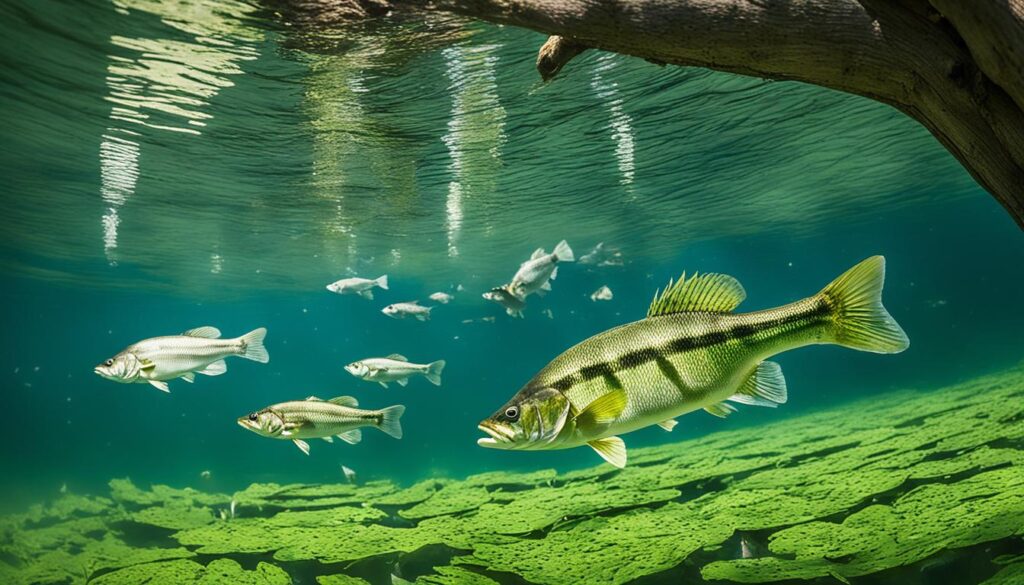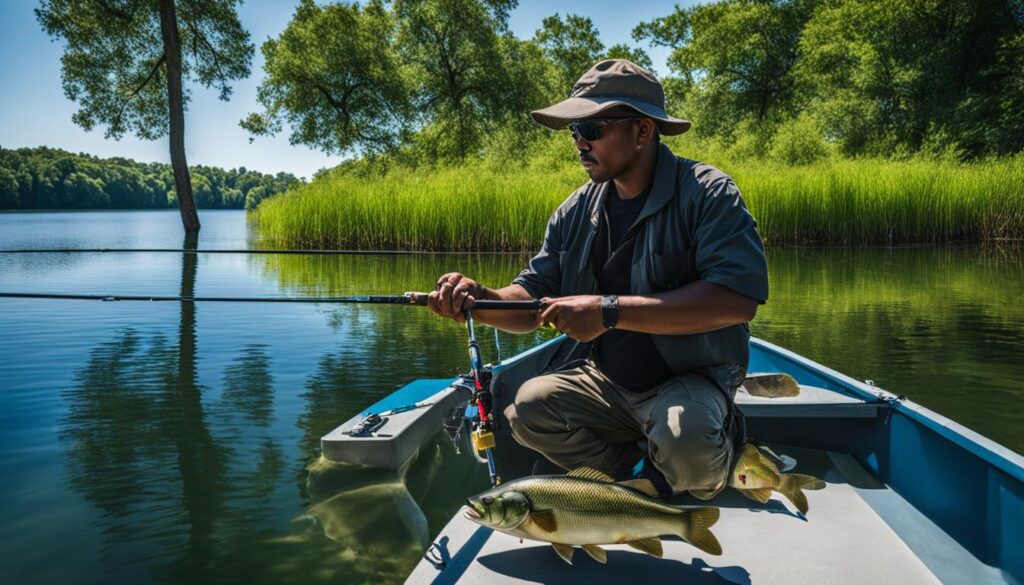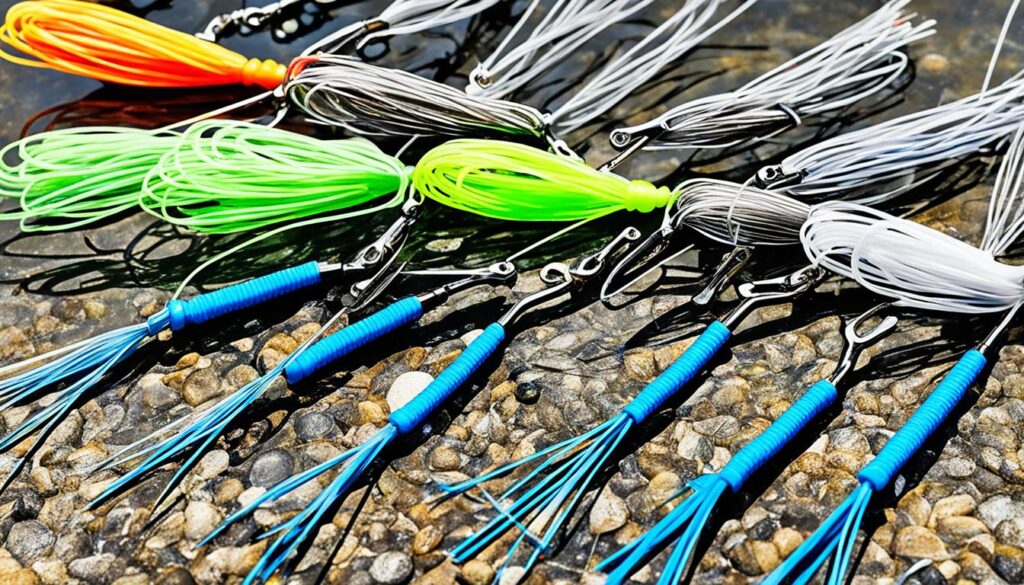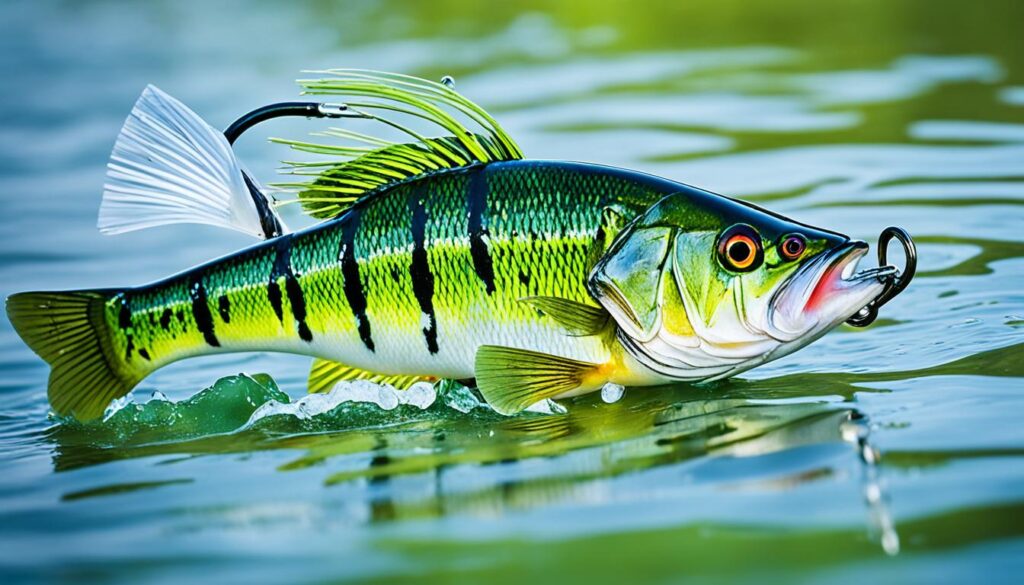Hello, fellow anglers! Today, I want to share some valuable spring swim jig bass fishing tips that will help you increase your chances of success on the water. If you’re looking to target bass in the spring and want to add swim jig techniques to your arsenal, you’ve come to the right place. In this article, I will provide you with essential spring fishing tactics, bass lure recommendations, and bass angling strategies specifically tailored for swim jig fishing. So, let’s dive in and explore the exciting world of spring swim jig bass fishing!
Key Takeaways:
- Swim jigs are effective lures for covering water when searching for active springtime bass.
- Having the right tackle, including swim jigs, trailers, rods, reels, and lines, is crucial for successful swim jig fishing.
- Understanding the behavior and preferred habitat of bass in the spring is essential for targeting them effectively.
- Mastering the art of swim jig fishing involves specific techniques and strategies.
- There are different types of bass jigs available, each suitable for specific fishing situations.
Choosing the Right Tackle for Swim Jig Fishing
When it comes to swim jig fishing, having the right tackle is essential. The right combination of swim jigs, jig trailers, fishing rods, fishing reels, and fishing lines can significantly improve your chances of success.
For swim jigs, some recommended options include the All Terrain Tackle Swim Jig and the Terminator Heavy Duty Swim Jig. These swim jigs are designed to provide the right action and profile that entice bass to strike.
To enhance the effectiveness of your swim jigs, consider using a quality jig trailer. The Reaction Innovations Spicy Beaver trailer is a popular choice that adds lifelike movement and appeal to your swim jig presentation.
When it comes to fishing rods, the St.Croix Avid Casting Rod (7′ Medium) is a reliable option. Its sensitivity and strength allow for precise casts and effective hook sets. Pair your rod with a high-performance fishing reel such as the Daiwa Tatula Elite Casting Reel (7.1:1) to ensure smooth line retrieval and control.
Choosing the right fishing line is also crucial for swim jig fishing. The Sufix 131 Braid (30-pound) is a durable and strong line that allows for accurate casts and gives you the confidence to tackle dense cover without worrying about line breakage.
By investing in the right tackle, you can maximize your chances of landing bass when fishing with swim jigs. The right combination of swim jigs, trailers, rods, reels, and lines will give you the tools you need to effectively target and entice bass in the spring.
Spring Bass Behavior and Habitat

Understanding the behavior and habitat of bass in the spring is key to successful swim jig fishing. During the prespawn period, which can last well into April and even late May in northern latitudes, bass are drawn to shallow water by warm fronts, seeking comfort and feeding opportunities.
One effective way to target bass during this time is by using swim jigs. These versatile lures are ideal for fishing in a variety of habitats, such as grass and wood flats, as well as around residual cover like cattails and submerged grass. By knowing the typical behavior and preferred habitat of bass in the spring, you can increase your chances of catching them.
“Understanding the behavior and habitat of bass in the spring is essential for successful swim jig fishing.”
| Spring Bass Behavior | Bass Habitat in Spring |
|---|---|
| Bass are drawn to shallow water by warm fronts. | Swim jigs are perfect for combining grass and wood flats. |
| The prespawn period lasts well into April and even late May in northern latitudes. | Fishing around residual cover like cattails and submerged grass can yield good results. |
| Bass seek comfort and feeding opportunities in shallow water. |
The Art of Swim Jig Fishing
Swim jig fishing is an art that requires specific techniques and strategies. One popular technique is reeling the swim jig quickly through the water, imitating a prey fish trying to escape from a predator. The retrieve speed can vary among anglers, but it is generally agreed that a fast retrieve can trigger more bites. It is important to reel the swim jig close to cover and make it swim right against or through it without breaking the surface. Adding subtle rod movements or pauses can also induce a reaction bite from bass. Mastering the art of swim jig fishing can help you catch more bass in the spring.
Different Types of Bass Jigs
When it comes to bass fishing, having the right jig can make all the difference. There are several types of bass jigs that are designed for specific fishing situations and techniques. Understanding these different types of jigs can help you choose the right one for your next fishing adventure.
Finesse Jigs
Finesse jigs are commonly used for finesse fishing, where a more subtle and delicate presentation is needed. These jigs typically have smaller diameters and lighter weights, allowing for a finesse approach. Finesse jigs are ideal for targeting inactive or finicky bass in clear or pressured waters.
Punch and Flipping Jigs
When fishing in heavy cover, such as thick vegetation or brush piles, punch and flipping jigs are the go-to choice. These jigs are designed with features like drilled cylinder heads, which allow them to penetrate through thick cover with ease. The heavy weight of punch and flipping jigs enables anglers to make precise and powerful casts into dense cover.
Football Jigs
Football jigs are versatile lures that excel at fishing on the bottom of lakes and other deep-water structures. They have a unique head shape that resembles a football, which allows them to stand upright on the bottom. This upright presentation mimics a crawfish or baitfish, enticing bass to strike. Football jigs are a popular choice for targeting bass in offshore structures.
Swim Jigs
Swim jigs are versatile lures that can be cast and retrieved like spinnerbaits or frogs. They are designed to imitate baitfish or other swimming prey, making them effective in a wide range of fishing scenarios. Swim jigs can be fished at various depths and speeds, allowing anglers to cover water efficiently and trigger strikes from active bass.
Each type of jig has its own characteristics and is suited for specific fishing situations. By understanding the different types of bass jigs, you can choose the right jig for your target species, fishing technique, and fishing conditions.
Having a variety of bass jigs in your tackle box will provide you with options and flexibility on the water. Whether you prefer finesse fishing, flipping into heavy cover, bottom fishing, or casting and retrieving, there is a jig that can help you catch more bass. Experiment with different types of jigs to find what works best in your fishing area and for your preferred techniques.
Advanced Swim Jig Tactics

When it comes to swim jig fishing, advanced tactics can take your game to the next level. By implementing these techniques, you can increase your chances of consistently catching more bass. Let’s explore some of these advanced swim jig tactics.
Fishing Along Edges
One effective strategy is to focus on fishing along edges. Bass tend to congregate along the edges of structures such as weed lines, drop-offs, and points. By casting your swim jig along these edges, you can target the areas where bass are most likely to be feeding.
Repeated Casting
Don’t be afraid to make repeated casts to the same area. Bass may not strike on the first cast, but they might get curious or aggravated by the constant presence of the swim jig. Repeated casting allows you to increase your chances of triggering a strike from a hesitant bass.
Craw Jigging in Winter
During the winter months, when bass are suspending in cold water, crawling a swim jig along the bottom of cliff edges can be highly effective. Start by casting your swim jig parallel to the cliff and slowly retrieve it, keeping it in contact with the structure. Adjust the speed of the crawl based on the water temperature to entice sluggish bass into biting.
To summarize, advanced swim jig tactics involve fishing along edges, making repeated casts, and employing craw jigging techniques in winter. By mastering these techniques, you can become a more skilled swim jig angler and increase your chances of landing more bass.
Gear Setup for Swim Jig Fishing

Having the right gear setup is crucial for successful swim jig fishing. The right fishing rod, reel, and line can greatly enhance your fishing experience and increase your chances of landing bass. Here’s what you need to know about the gear setup for swim jig fishing:
1. Fishing Rod for Swim Jigs
A medium to fast action fishing rod with a length of 6′ to 7′ is recommended for swim jig fishing. This length and action combination provide the necessary sensitivity and power to effectively work swim jigs through the water and set the hook when a bass strikes. Some popular fishing rod brands for swim jigs include G. Loomis, St. Croix, and Dobyns.
2. Fishing Reel for Swim Jigs
Baitcasting reels are commonly used for swim jig fishing due to their accuracy, control, and ability to handle heavier lines. Look for a reel with a gear ratio around 6:1 or 7:1 for optimal swim jig retrieves. If you prefer spinning reels, make sure to choose one that is long and stiff enough to handle the weight and action of swim jigs. Some reputable fishing reel brands for swim jigs include Shimano, Daiwa, and Abu Garcia.
3. Line Choice for Swim Jig Fishing
The right fishing line can make a significant difference when fishing with swim jigs. Fluorocarbon or monofilament lines with a higher pound test are preferred for their durability and ability to handle thick cover. A 15 to 20-pound test line is usually sufficient for most swim jig fishing situations. Some popular fishing line brands for swim jigs include Seaguar, Berkley, and Sufix.
Having the right gear setup can improve your casting technique, retrieve, and hook set when fishing with swim jigs. The right rod, reel, and line combination will provide the strength, sensitivity, and control needed to effectively work swim jigs through the water and entice bass to bite.
Best Practices for Fishing with Jigs
When it comes to fishing with jigs, there are some best practices that can significantly improve your chances of success. Whether you’re targeting bass, walleye, or other game fish, following these tips can help you maximize your jig fishing experience.
Choosing the Right Jig Color
One of the key considerations when fishing with jigs is selecting the right color. The color of your jig can make a significant difference in attracting the attention of bass or other fish species. In stained or murky water, darker colors such as black, brown, or green pumpkin can be highly effective. On the other hand, in clear water conditions, lighter colors like white, chartreuse, or pink can be more enticing to fish.
Selecting the Right Jig Trailer
The choice of jig trailer can also play a crucial role in enticing bites from fish. The jig trailer adds movement and action to the jig, making it more attractive to fish. Crawfish imitations and paddle tails are popular choices for jig trailers as they mimic natural prey and trigger aggressive strikes. Experimenting with different trailers and observing how fish respond can help you find the perfect combination for a successful fishing trip.
Mastering Jig Fishing Techniques
Effective jig fishing techniques can help you entice strikes and land more fish. One technique is the hop-and-pop retrieve, where you lift the jig off the bottom and then allow it to flutter down again, imitating a wounded baitfish. Another technique is dragging the jig along the bottom, simulating a crawfish moving along the substrate. Varying your retrieval speed, incorporating pauses, and adapting to the fish’s behavior can make a significant difference in your fishing success.
“Choosing the right color and trailer for your jig and mastering various fishing techniques are essential for consistently catching fish.” – Expert Angler
Keeping the Jig in the Strike Zone
An important aspect of jig fishing is keeping the jig in the strike zone for as long as possible. This means casting accurately to the target area and maintaining contact with the jig throughout the retrieve. Paying attention to the details like detecting subtle changes in the line’s tension and feeling the bottom structure can help you identify potential fishing spots and increase your hookup rate.
Adapting to Changing Conditions
Lastly, being adaptable and open to change is crucial for successful jig fishing. Fish behavior and environmental conditions can vary, so it’s important to adjust your approach accordingly. If you’re not getting any bites, consider changing the color, size, or trailer of your jig. Additionally, pay attention to subtle clues such as fish movement or feeding patterns to improve your chances of success.
| Best Practices for Fishing with Jigs | Jig Fishing Techniques | Jig Color Choice | Selecting the Right Jig Trailer |
|---|---|---|---|
| Choose the right equipment: rod, reel, and line | Experiment with different retrieves: hop-and-pop, dragging | Consider water clarity: darker colors for murky water, lighter colors for clear water | Try different trailer types: crawfish imitations, paddle tails |
| Maintain contact with the jig throughout the retrieve | Pay attention to fish behavior and adjust your techniques accordingly | Observe fish response and adapt colors based on their preference | Match the jig trailer to the prevailing forage in the area |
| Keep the jig in the strike zone by accurate casting | Vary the retrieval speed and pauses to trigger more strikes | Use natural or contrasting colors to stand out in the water | Experiment with trailer sizes to find the right balance |
Benefits of Swim Jig Fishing in Spring
Swim jig fishing in spring offers numerous benefits for anglers. The versatility of swim jigs allows them to imitate various prey fish, making them highly effective in a wide range of fishing situations. One significant advantage of swim jigs is the ability to cover water efficiently, maximizing the chances of finding active bass. Whether you’re targeting shallow water or fishing around different types of cover, swim jigs are suitable for various habitats, allowing you to adapt your fishing strategy accordingly. The popularity of swim jig fishing in the spring stems from its versatility and effectiveness in targeting bass, making it a go-to choice for many anglers.
Swim jigs offer several advantages that contribute to their effectiveness on the water. Firstly, their design allows for easy maneuverability, enhancing their versatility and adaptability to different fishing scenarios. Furthermore, swim jigs provide a lifelike presentation that closely resembles the natural movements of baitfish, triggering the predatory instincts of bass. This realistic action, coupled with the enticing colors and patterns available in swim jigs, can make all the difference in enticing a strike.
Another benefit of swim jig fishing is the efficiency with which you can cover water. This is crucial, especially during the spring when bass are actively moving and transitioning to spawning areas. By casting swim jigs and retrieving them at various speeds, you can effectively explore different areas and identify productive spots. This methodical approach saves time and increases your chances of landing bass.
Moreover, swim jigs are versatile lures that excel in different types of cover. Whether it’s submerged grass, wood flats, or cattails, swim jigs can be fished effectively around these areas. Their weedless design allows you to navigate through vegetation without getting snagged, ensuring a hassle-free fishing experience. Additionally, swim jigs can be worked at different depths, making them suitable for both shallow and deeper water situations.
In conclusion, swim jig fishing in the spring offers anglers a wide range of benefits. The versatility and effectiveness of swim jigs, coupled with their ability to cover water efficiently, make them a go-to lure for targeting bass. Whether you’re a seasoned angler or a beginner, incorporating swim jigs into your spring fishing arsenal can significantly enhance your chances of success on the water.
Conclusion
Spring swim jig bass fishing is an incredibly rewarding and successful technique for anglers. By mastering the swim jig bass basics, selecting the right tackle, and employing effective fishing techniques, you can significantly increase your chances of catching bass in the spring. The versatility of swim jigs allows you to cover water efficiently and target bass in various habitats and fishing situations.
When it comes to gear setup, it’s important to have the right tools for the job. A medium to fast-action fishing rod, paired with a suitable baitcasting reel or spinning reel, will provide you with the accuracy and control needed to effectively fish with swim jigs. Choosing the right fishing line, such as fluorocarbon or monofilament, will ensure durability and the ability to handle thick cover.
Understanding the behavior of bass in the spring is essential for successful swim jig fishing. Utilizing your knowledge of where and how bass are likely to be during the prespawn period can greatly improve your chances of success. By combining this knowledge with the right gear setup and effective swim jig fishing techniques, you’ll be able to unlock the secrets of spring bass fishing and experience the thrill of catching more bass.
In conclusion, spring swim jig bass fishing offers a fantastic opportunity to catch bass during this exciting time of year. By mastering the basics, selecting the right tackle, and understanding bass behavior, you’ll be well-equipped to enjoy a successful fishing season. So grab your swim jigs, head out on the water, and get ready to reel in some trophy bass!
FAQ
What are some bass fishing tips for spring swim jig success?
To increase your chances of success when fishing with swim jigs in the spring, it is important to have the right tackle, including swim jigs, trailers, rods, reels, and lines. Additionally, understanding the behavior and habitat of bass in the spring can help you effectively target them. Mastering the art of swim jig fishing and using advanced tactics can also improve your success rate.
What tackle should I use for swim jig fishing?
Recommended tackle for swim jig fishing includes All Terrain Tackle Swim Jig, Terminator Heavy Duty Swim Jig, Reaction Innovations Spicy Beaver trailer, St.Croix Avid Casting Rod (7′ Medium), Daiwa Tatula Elite Casting Reel (7.1:1), and Sufix 131 Braid (30-pound). Having the right tackle can increase your chances of success when fishing with swim jigs in the spring.
How can I effectively target bass in the spring with swim jigs?
Understanding the behavior and preferred habitat of bass in the spring is essential. The prespawn period for bass in northern latitudes can extend well into April and even late May. Warm fronts bring bass into shallow water for comfort and feeding opportunities. Swim jigs are ideal for combining grass and wood flats, as well as fishing around residual cover like cattails and submerged grass.
What are some techniques for fishing with swim jigs?
One popular technique is reeling the swim jig quickly through the water to imitate a prey fish trying to escape from a predator. It is important to reel the swim jig close to cover and make it swim right against or through it without breaking the surface. Adding subtle rod movements or pauses can also induce a reaction bite from bass.
What are the different types of bass jigs?
There are several types of bass jigs that can be used for different fishing situations. Finesse jigs are commonly used for finesse fishing, punch and flipping jigs are designed for fishing in heavy cover, football jigs are effective for fishing on the bottom of lakes, and swim jigs are versatile lures that can be cast and retrieved like spinnerbaits or frogs.
Are there any advanced tactics for swim jig fishing?
Yes, advanced swim jig tactics can help you catch more consistent bass. Fishing along edges and casting repetitively can increase your chances of getting a bite. When fishing with swim jigs in the winter, you can crawl the jig along the bottom of cliff edges to target cold-water suspending bass. These tactics can be effective in challenging fishing conditions and can help you improve your swim jig fishing skills.
What gear setup should I use for swim jig fishing?
It is crucial to have the right gear setup for successful swim jig fishing. A medium to fast action fishing rod with a length of 6′ to 7′ is recommended. Baitcasting reels are commonly used for their accuracy and control, but spinning reels can also be effective if they are long and stiff enough. When choosing a fishing line for swim jig fishing, fluorocarbon or monofilament lines with a higher pound test are preferred for their durability and ability to handle thick cover.
Are there any best practices for fishing with jigs?
When fishing with jigs, choosing the right jig color can make a difference in attracting bass. Darker colors are preferred in stained water, while lighter colors are better for clear water. Selecting the right jig trailer, such as crawfish imitations and paddle tails, can also play a role in enticing bites from bass. Experimenting with different techniques, colors, and trailers can help you find what works best for you when fishing with jigs.
What are the benefits of swim jig fishing in spring?
Swim jig fishing in the spring offers several benefits for anglers. Swim jigs are versatile lures that can be used to imitate various prey fish and are effective in a wide range of fishing situations. They allow anglers to cover water efficiently, increasing the chances of finding active bass. Swim jigs can be fished in shallow water and around various types of cover, making them suitable for different habitats.
